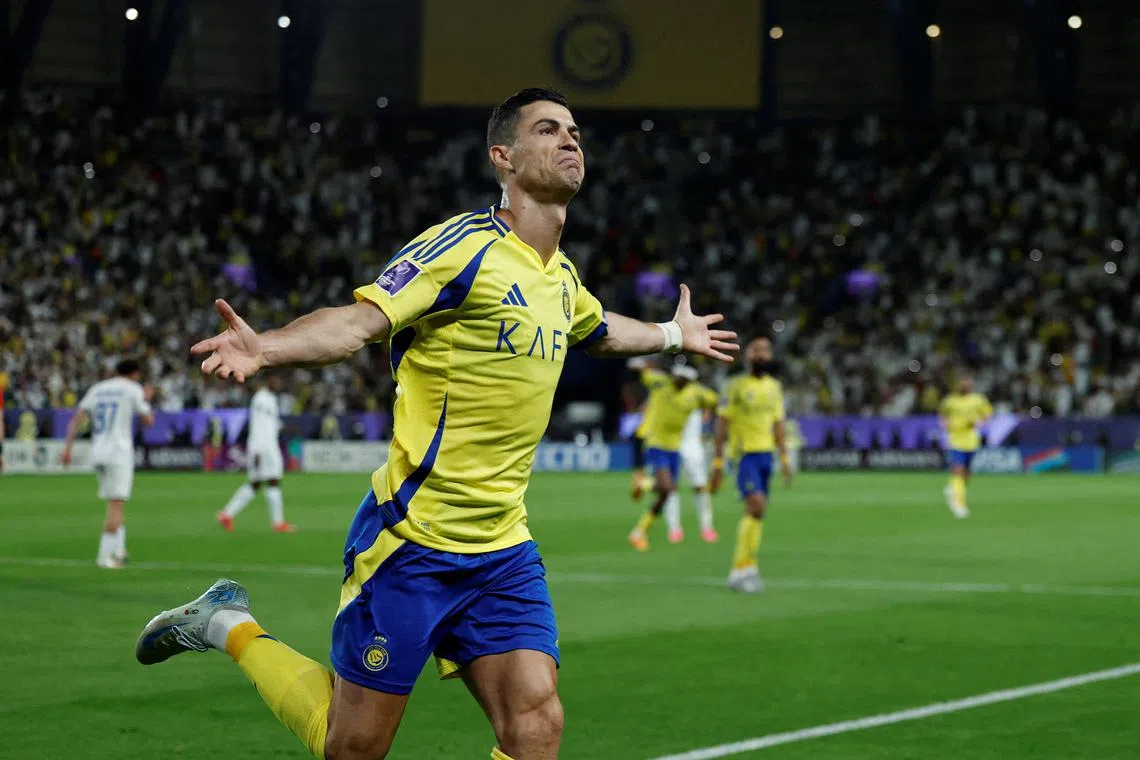Ronaldo, Hamilton and LeBron excel at 40 with modern science
Sign up now: Get the biggest sports news in your inbox

Cristiano Ronaldo is 40 but still going strong at his age. He is the Saudi Pro League's top scorer.
PHOTO: REUTERS
Follow topic:
LONDON – Cristiano Ronaldo turned 40 in February and is top scorer in Saudi football’s top flight. Lewis Hamilton hit the same age in January and is chasing an eighth Formula One title. LeBron James, also recently 40, is the first National Basketball Association (NBA) player to score 50,000 combined points.
They are big-name examples of the growing multitude of modern sportspersons performing at remarkable levels at an age when in yesteryear they would probably be long retired.
Experts attribute the growing longevity in elite sport to a host of steadily evolving conditions – from improved diet and mental well-being to better recovery and training facilities.
“A whole constellation of factors... it’s like pouring gasoline,” performance nutritionist Marc Bubbs, author of Peak – about science in sport – said of the additional factors fuelling top performance.
In his field – nutrition – athletes are far more thoughtful about what they eat, some hiring chefs to prepare tailored meals, others like Hamilton embracing high-fibre, plant-based diets.
“They should be getting injured more, but they aren’t,” added Dr Bubbs, of the improved health for older competitors.
In Europe's top five football leagues, the number of over-35 players topped 100 for the first time in 2020 and has been there for all but one of the following years, according to database Transfermarkt.
By contrast, in 1980, there were only 12 men of that age playing in those elite leagues.
In tennis, the trio of Novak Djokovic, Rafael Nadal and Roger Federer famously dominated their sport into ages that would previously have been considered senior.
At 37, Djokovic continues to compete at the highest level, crediting advancements in nutritional science. Mid-career, he adopted a gluten-free diet, eliminating gluten, dairy, and processed foods, which he believes enhanced his health and performance.
“Suddenly there was an X factor, a change in my diet that allowed my body to perform the way it was meant to,” the world No. 5 wrote in his book Serve To Win.
The ATP men’s singles top 100 currently has more than 10 over-30s, with five of them over-35 whereas back in 1995 there were six over-30s.
In women’s tennis too, 19 of the top 100 WTA singles rankings are 30-plus, with the oldest, Tatjana Maria and Laura Siegemund, both 37. Back in 2001, there had been only four 30-plus players in the top 100, according to the WTA website.
Financial incentives, including lucrative contracts and increased investments, motivate athletes to extend their careers. Additionally, substantial sponsorship deals and endorsements contribute to prolonged athletic participation.
NBA teams are investing heavily in advanced training facilities to attract top talent, enhance performance, and expedite recovery.
Cleveland Cavaliers plan to have a new training facility by 2027 as part of a US$3.5 billion (S$4.7 billion) building plan.
The Detroit Pistons spent US$90 million on their performance facility including a rehabilitation unit – a far cry from the gritty 1980s and 1990s when the so-called “Bad Boy” Pistons were running roughshod in more basic conditions.
“The environment is one of the most important things to make people change their behaviours,” explained Dr Bubbs.
That has enabled players, like James, to go on far longer than predecessors. The Lakers forward takes extreme care of his body, for example using hyperbaric oxygen therapy to aid his recovery from injuries and fatigue.
“Our mindset has totally shifted... I think you are seeing the Bannister effect for ageing,” said Steven Kotler, a US author on human performance, comparing later-life athletic breakthroughs with smashing barriers like Roger Bannister’s first sub-four minute mile in 1954. REUTERS

